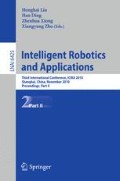Abstract
Musculoskeletal modeling is an important step in understanding the behavior of a body part for postural and motion control. A simple but reliable model is preferred over more complex models. Most of the musculoskeletal models that have been developed so far involved a number of parameters that sometimes, some of the parameters are not easily identified or require difficult or expensive procedures. In this paper, a simplification strategy of the musculoskeletal model in 1 degree of freedom (DOF) hand tremulous motion is presented. The key idea of the complexity reduction mainly on the combination of the two inputs into single input using a sequence of signal processing. 3 models (first order, second order and second order with one zero) plus time delay are considered to represent the simplified musculoskeletal model. The best fit was represented by a second order plus time delay and one zero.
Access this chapter
Tax calculation will be finalised at checkout
Purchases are for personal use only
Preview
Unable to display preview. Download preview PDF.
References
Hof, A.L.: EMG and muscle force: An introduction. Human Movement Science 3, 119–153 (1984)
Langenderfer, J., LaScalza, S., Mell, A., Carpenter, J.E., Kuhn, J.E., Hughes, R.E.: An EMG-driven model of the upper extremity and estimation of long head biceps force. Computers in Biology and Medicine 35, 25–39 (2005)
Hof, A.L., Van den Berg, J.: EMG to force processing I: An electrical analogue of the hill muscle model. Journal of Biomechanics 14, 747–753, 755-758 (1981)
Bestel, J., Clément, F., Sorine, M.: A Biomechanical Model of Muscle Contraction. In: Niessen, W.J., Viergever, M.A. (eds.) MICCAI 2001. LNCS, vol. 2208, pp. 1159–1161. Springer, Heidelberg (2001)
Dijkstra, S., Denier van der Gon, J.J., Blangé, T., Karemaker, J.M., Kramer, A.E.J.L.: A simplified sliding-filament muscle model for simulation purposes. Biological Cybernetics 12, 94–101 (1973)
Hayashibe, M., Guiraud, D., Poignet, P.: EMG-based neuromuscular modeling with full physiological dynamics and its comparison with modified hill model. In: Annual International Conference of the IEEE Engineering in Medicine and Biology Society, EMBC 2009, pp. 6530–6533 (2009)
Bean, J.C., Chaffin, D.B., Schultz, A.B.: Biomechanical model calculation of muscle contraction forces: A double linear programming method. Journal of Biomechanics 21, 59–66 (1988)
Wexler, A.S., Jun, D., Binder-Macleod, S.A.: A mathematical model that predicts skeletal muscle force. IEEE Transactions on Biomedical Engineering 44, 337–348 (1997)
Terry, K.K.K., Arthur, F.T.M.: Feasibility of using EMG driven neuromusculoskeletal model for prediction of dynamic movement of the elbow. Journal of electromyography and kinesiology: official journal of the International Society of Electrophysiological Kinesiology 15, 12–26 (2005)
David, G.L., Thor, F.B.: An EMG-driven musculoskeletal model to estimate muscle forces and knee joint moments in vivo. Journal of Biomechanics 36, 765–776 (2003)
Burkhard, P.R., Langston, J.W., Tetrud, J.W.: Voluntarily simulated tremor in normal subjects. Neurophysiologie Clinique/Clinical Neurophysiology 32, 119–126 (2002)
Conforto, S., Mathieu, P., Schmid, M., Bibbo, D., Florestal, J.R., D’Alessio, T.: How much can we trust the electromechanical delay estimated by using electromyography? In: 28th Annual International Conference of the IEEE in Engineering in Medicine and Biology Society, EMBS 2006, pp. 1256–1259 (2006)
Author information
Authors and Affiliations
Editor information
Editors and Affiliations
Rights and permissions
Copyright information
© 2010 Springer-Verlag Berlin Heidelberg
About this paper
Cite this paper
Ruwadi, Yap, S.C., Poignet, P., Tech, A.W. (2010). Model Complexity Reduction of the Hand Musculoskeletal System in Tremulous Motion. In: Liu, H., Ding, H., Xiong, Z., Zhu, X. (eds) Intelligent Robotics and Applications. ICIRA 2010. Lecture Notes in Computer Science(), vol 6425. Springer, Berlin, Heidelberg. https://doi.org/10.1007/978-3-642-16587-0_40
Download citation
DOI: https://doi.org/10.1007/978-3-642-16587-0_40
Publisher Name: Springer, Berlin, Heidelberg
Print ISBN: 978-3-642-16586-3
Online ISBN: 978-3-642-16587-0
eBook Packages: Computer ScienceComputer Science (R0)

